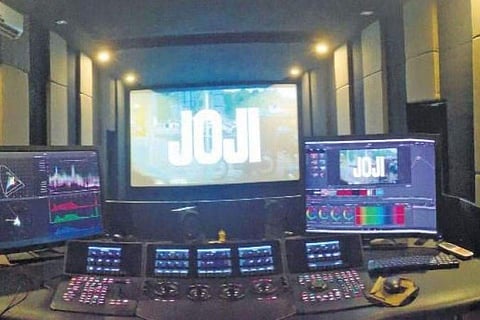
- LIFESTYLE
- FASHION
- FOOD
- ENTERTAINMENT
- EVENTS
- CULTURE
- VIDEOS
- WEB STORIES
- GALLERIES
- GADGETS
- CAR & BIKE
- SOCIETY
- TRAVEL
- NORTH EAST
- INDULGE CONNECT

Until the late 2000s, Mollywood relied on film studios in Chennai, Hyderabad and Mumbai for film post-production work. However, with the mushrooming of private film studios in Kerala, this trend of ‘outsourcing’ the work has waned in recent years. Now, a majority of the post-production work is done from studios here.
“Earlier, we used to send our projects to studios in other cities to complete the post-production work. This has changed. Now, the post-production work for even big projects like Maari 1 and 2, Kantara, Toby, 777 Charlie and Gandhadagudi was done here,” says Sumesh Gopal, the technical director of Digibricks Entertainments, a film studio based in Chembumukku, Kochi.
The innate love for films in Kerala and a growing talent pool have seen many national-level VFX and animation companies set up bases here. Experts in the field state this as also one of the reasons why post-production work has come ‘home’.
“There’s an abundance of talented people here. One need only check the credits of a Hollywood movie to glean this. Malayali names litter that list. I’ll also venture to say that Malayalis and South Indians have a special knack in this field,” adds Sumesh.
But even when the job was outsourced, it was still Malayalis working in studios in these big metro cities who were tasked with the post-production work, says Anish Dayanandan, the founder of Digibricks.
In fact, Anish is one of those Malayalis. Prior to starting his VFX studio, he had stints in major companies like Green Gold Animation in Hyderabad and Rhythm and Hues in Mumbai. Like him, there are several who’ve returned home and started their own ventures, thus shaping the industry landscape in the region and raising the standards.
According to Ramesh C P, a DI colourist at Colour Planet, Kochi, the quality of work Malayali artists produce even attracts filmmakers from outside Kerala. “They are all keeping a close eye. The producers of Kantara approached me after noticing my work in Kumbalangi Nights and other movies,” says Ramesh.
If this influx of experienced talent provided the foundation, what cemented the industry in the state was the advent of digital tools that made it so that anyone with a computer and necessary software could set up a studio. Anish is one of the earliest beneficiaries of this seismic shift. “When I launched my studio in 2009, there wasn’t even a single studio in Kochi. Film studios started flourishing here only in the mid-2010s,” Anish says.
Though digital tools have made it so that a laptop is now the entire studio, there are instances that necessitate going to the ‘office’. “The latest facilities are only available in Kochi, Also, for huge and complex projects, Mollywood, on occasion, depends on the ecosystem available in Chennai or Mumbai,” says Jayadevan C, a sound designer at Bell Audio, Kochi.
This is, in part, a hangover of that lingering perception that only huge studios are capable of producing good output.
Did you know?
When Digibricks started operations in Kerala, they had to wait a full year before work became available to them. “It was tough at first. We had to prove ourselves to attract clients. Now, we receive work from even the big cities,” says Sumesh.
There is also another caveat. Ideally, post-production work should be done where discussions on the planning and production are also taking place. “Since most of the Mollywood films are shot in Kerala, it is only natural to also want the post-production to be done here too,” Jayadevan adds.
Now, about 80-90% of Mollywood films get their post-production work done in Kerala. The VFX for recent movies like 2018, RDX, Bheeshma Parvam, and Thallumaala were done by multiple studios in the state.
The change in trend has also come with an associated boon -- reduced costs. “When we depend on big companies and studios in other states, the operation costs shoot up. This is not the case if the work is done in Kerala. This drastic reduction in cost has not only helped producers release their low-budget movies without incurring too much expense but also use whatever amount they saved to tinker with new film technologies,” says Sumesh.
According to Vipin Mannoor, a film editor with Post Focus Entertainment in Thiruvananthapuram, affordability is the most significant factor that helped the industry thrive in Kerala. “Technology has levelled the playing field. Today, one doesn’t need huge infrastructure to start editing or audio mixing,” says Vipin.
That said, the industry remains largely unorganised. Most take to this profession on their own and engage in the industry as freelancers. There was news of the Kerala State Film Development Corporation putting together a draft policy on AVGC-XR (animation, visual effects, gaming, comics, and extended reality) with an aim to make the state an AVGC-XR hub. Such projects with long-term vision can greatly augment the sector.
Glimpse into past
Earlier, most of the post-production was done manually and required various equipment. Film rolls were used to shoot and store the content. Since most of these tools were only available in big studios in metro cities, Mollywood had no other option but to send the material for editing there. “There were technical limitations in setting up a post-production studio. Also, it involved a huge capital. Now, we store our work in a hard disk,” says Anish Dayanandan, the founder of Digibricks.
Rs 100-CRORE PUSH
To give further impetus to this flourishing industry, the Kerala State Film Development Corporation recently announced a Rs 100-crore project to open a Kochi branch for Chitranjali, a state-run studio.
Also read: Ranbir Kapoor exudes intensity in new ‘Animal’ poster, teaser to be released on this date